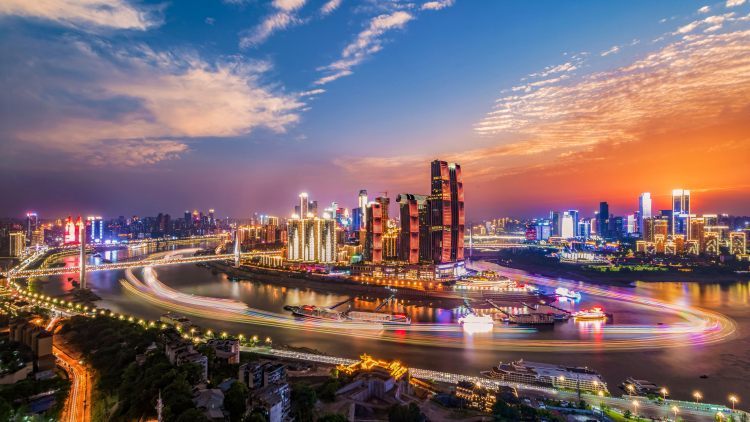
The night view of Chongqing. (Photo/Chongqing Municipal Commission of Culture and Tourism Development)
Chongqing, the only municipality directly under the central government in China's central and western regions, is striving to become an international, environmentally friendly, technologically advanced, and culturally modern metropolis.
Located in the southwest inland area of China and the upper reaches of the Yangtze River, Chongqing forms part of the Chengdu-Chongqing economic circle, emerging as the "fourth pole" of China's economy after the Beijing-Tianjin-Hebei region, the Yangtze River Delta, and the Guangdong-Hong Kong-Macao Greater Bay Area.
By the end of 2022, Chongqing's permanent population was 32.13 million, with an urbanization rate of 70.96 percent. The majority of the population comprises the Han ethnic group, with ethnic minorities such as the Tujia and Miao ethnic groups.
Chongqing covers an area of 82,400 square kilometers and has jurisdiction over 38 districts and counties (26 districts, eight counties, and four autonomous counties).
Chongqing is known as a unique "mountain city" and a "city on rivers," with its landforms primarily consisting of hills and mountains, accounting for 76 percent of the area. The Yangtze River runs through the entire territory, spanning a length of 691 kilometers, and intersects with other rivers, such as the Jialing River and Wujiang River.
Chongqing boasts abundant tourism resources, including the Three Gorges of the Yangtze River, the Dazu Rock Carvings (a cultural world heritage site), the Wulong Karst (a natural world heritage site), and Mount Jinfo in Nanchuan District.
As a famous historical and cultural city in China, Chongqing has a recorded history of over 3,000 years and is the birthplace of Bayu culture. It is also called "Yu" due to the ancient name of the Jialing River (Yu River). In 1891, Chongqing became the earliest inland trading port in China to open up to international trade, and in 1929, it was officially established as a municipality.
Chongqing is a crucial strategic pivot for Western development, situated at the convergence zone of the Belt and Road Initiative and the Yangtze River Economic Belt. It plays a unique and significant role in China's regional development and opening-up strategy.
In the first three quarters of 2023, Chongqing's GDP reached 2.2243 trillion yuan($311.33 billion), growing by 5.6 percent year-on-year.
Chongqing has been seeing robust growth in the number of rail-sea intermodal trains of the New International Land-Sea Trade Corridor to fast-track its development as an inland hub of international trade. Between January and November 2023, the corridor facilitated the transport of 145,000 TEUs, a 26 percent increase compared to the previous year. The total value of these goods reached 18.46 billion yuan.
Chongqing is expediting the transformation and upgrading of its economic structure, revitalizing its old industrial base, and establishing significant clusters in the global electronic information industry and the domestic automobile industry.
Strategic emerging industries such as equipment manufacturing, biopharmaceuticals, and new materials are flourishing, and the construction of the Liangjiang New Area and the Western China (Chongqing) Science City is being carried out to high standards.
The development driven by innovation and big data intelligence is being vigorously promoted, resulting in breakthroughs in constructing a "smart manufacturing powerhouse" and a "renowned smart city."
Chongqing has won the critical battle against poverty and developing a moderately prosperous society in all respects as planned. This has continuously improved people's sense of fulfillment, happiness, and security.
The city has also accelerated its infrastructure development, with a total of 4,000 kilometers of expressways now open to traffic. It has established a railway network known as the "one hub and ten main lines" and has expedited the construction, ongoing projects, and operational mileage of a star-shaped high-speed railway network spanning 1,940 kilometers, as well as 109 international routes.
Chongqing is expediting the construction of a crucial ecological shield in the upper reaches of the Yangtze River. The water quality in the main streams of the Yangtze River, Jialing River, and Wujiang River is generally excellent, with 332 days of excellent air quality in 2022. Additionally, the forest coverage rate in the city reached 55 percent in the same year.
(This article is updated on January 4, 2024)
By continuing to browse our site you agree to our use of cookies, revised Privacy Policy and Terms of Use. You can change your cookie settings through your browser.
For any inquiries, please email service@ichongqing.info